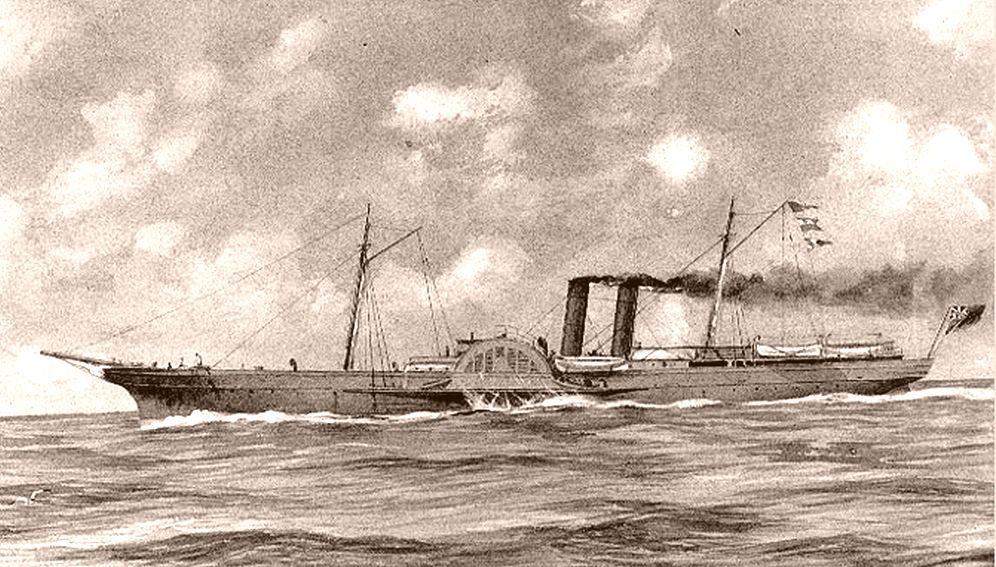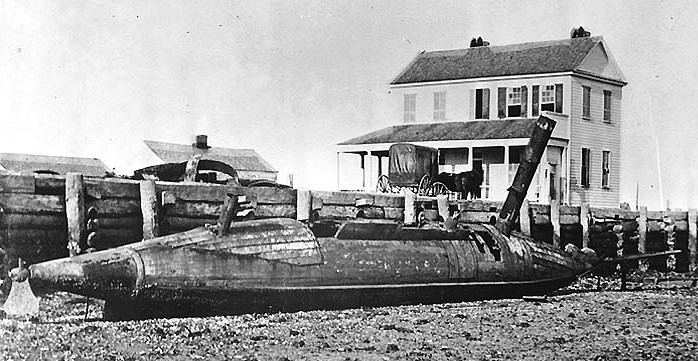|
CSS David
CSS ''David'' was an American Civil War-era torpedo boat. On October 5, 1863, she undertook a partially successful attack on which was participating in the blockade of Charleston, South Carolina. Construction Based upon a design by St. Julien Ravenel, ''David'' was built as a private venture by T. Stoney at Charleston, South Carolina, in 1863, and was put under the control of the Confederate States Navy (CSN). The cigar-shaped boat carried a explosive charge of gunpowder on the end of a spar projecting forward from her bow. CSS ''David'' operated as a semi-submersible: water was taken into ballast tanks so that only the length of the open-top conning tower and the stack for the boiler appeared above water. Designed to operate very low in the water, ''David'' resembled in general a submersible submarine; she was, however, strictly a surface vessel. Operating on dark nights, and using anthracite coal (which burns without smoke), ''David'' was nearly as hard to see as a true ... [...More Info...] [...Related Items...] OR: [Wikipedia] [Google] [Baidu] |
Spar Torpedo
A spar torpedo is a weapon consisting of a bomb placed at the end of a long pole, or spar, and attached to a boat. The weapon is used by running the end of the spar into the enemy ship. Spar torpedoes were often equipped with a barbed spear at the end, so it would stick to wooden hulls. A fuse could then be used to detonate it. Invention Robert Fulton had written about submarine (i.e., subsurface) marine torpedoes in 1810, and experiments were conducted using spar torpedoes that year. Boats carrying spar torpedoes were used during the War of 1812. E. C. Singer, a private engineer who worked on secret projects for the benefit of the Confederate States of America, constructed a spar torpedo during the American Civil War. His torpedo was detonated by means of a trigger mechanism adapted from a rifle lock (see flintlock mechanism for a similar device). The spring-loaded trigger was detonated by means of a long cord attached to the attacking vessel. The attacking vessel rammed its ... [...More Info...] [...Related Items...] OR: [Wikipedia] [Google] [Baidu] |
Seaman (rank)
Seaman is a military rank used in many Navy, navies around the world. It is considered a junior enlisted rank and, depending on the navy, it may be a single rank on its own or a name shared by several similarly junior ranks. In the Commonwealth of Nations, Commonwealth, it is the lowest rank in the navy, while in the United States, it refers to the three lowest ranks of the United States Navy, U.S. Navy and United States Coast Guard, U.S. Coast Guard. The equivalent of the seaman is the ''matelot'' in French-speaking countries, and ''Matrose'' in German-speaking countries. Australia The Royal Australian Navy features one seaman rank, which is split into two distinct classes. Seaman and seaman* (pronounced "seaman star"), to differentiate between those who have completed their employment training and those who are in training. There is no insignia on a seaman rank slide. Canada There are 4 grades of sailor (previously the term "seaman", until it was replaced with "sailor" in ... [...More Info...] [...Related Items...] OR: [Wikipedia] [Google] [Baidu] |
Ships Built In Charleston, South Carolina
A ship is a large watercraft that travels the world's oceans and other sufficiently deep waterways, carrying cargo or passengers, or in support of specialized missions, such as defense, research, and fishing. Ships are generally distinguished from boats, based on size, shape, load capacity, and purpose. Ships have supported exploration, trade, warfare, migration, colonization, and science. After the 15th century, new crops that had come from and to the Americas via the European seafarers significantly contributed to world population growth. Ship transport is responsible for the largest portion of world commerce. The word ''ship'' has meant, depending on the era and the context, either just a large vessel or specifically a ship-rigged sailing ship with three or more masts, each of which is square-rigged. As of 2016, there were more than 49,000 merchant ships, totaling almost 1.8 billion dead weight tons. Of these 28% were oil tankers, 43% were bulk carriers, and 13% were con ... [...More Info...] [...Related Items...] OR: [Wikipedia] [Google] [Baidu] |
Torpedo Boats Of The Confederate States Navy
A modern torpedo is an underwater ranged weapon launched above or below the water surface, self-propelled towards a target, and with an explosive warhead designed to detonate either on contact with or in proximity to the target. Historically, such a device was called an automotive, automobile, locomotive, or fish torpedo; colloquially a ''fish''. The term ''torpedo'' originally applied to a variety of devices, most of which would today be called mines. From about 1900, ''torpedo'' has been used strictly to designate a self-propelled underwater explosive device. While the 19th-century battleship had evolved primarily with a view to engagements between armored warships with large-caliber guns, the invention and refinement of torpedoes from the 1860s onwards allowed small torpedo boats and other lighter surface vessels, submarines/submersibles, even improvised fishing boats or frogmen, and later light aircraft, to destroy large ships without the need of large guns, though some ... [...More Info...] [...Related Items...] OR: [Wikipedia] [Google] [Baidu] |
Washington DC
) , image_skyline = , image_caption = Clockwise from top left: the Washington Monument and Lincoln Memorial on the National Mall, United States Capitol, Logan Circle, Jefferson Memorial, White House, Adams Morgan, National Cathedral , image_flag = Flag of the District of Columbia.svg , image_seal = Seal of the District of Columbia.svg , nickname = D.C., The District , image_map = , map_caption = Interactive map of Washington, D.C. , coordinates = , subdivision_type = Country , subdivision_name = , established_title = Residence Act , established_date = 1790 , named_for = George Washington, Christopher Columbus , established_title1 = Organized , established_date1 = 1801 , established_title2 = Consolidated , established_date2 = 1871 , established_title3 = Home Rule Act , ... [...More Info...] [...Related Items...] OR: [Wikipedia] [Google] [Baidu] |
Blockade Runners Of The American Civil War
The blockade runners of the American Civil War were seagoing steam ships that were used to get through the Union blockade that extended some along the Atlantic and Gulf of Mexico coastlines and the lower Mississippi River. The Confederate states were largely without industrial capability and could not provide the quantity of arms and other supplies needed to fight against the industrial north. To meet this need blockade runners were built in Scotland and England and were used to import the guns, ordnance and other supplies that the Confederacy desperately needed, in exchange for cotton that the British textile industry needed greatly. To penetrate the blockade, these relatively lightweight shallow draft ships, mostly built in British ship yards and specially designed for speed, but not suited for transporting large quantities of cotton, had to cruise undetected, usually at night, through the Union blockade. The typical blockade runners were privately owned vessels often operatin ... [...More Info...] [...Related Items...] OR: [Wikipedia] [Google] [Baidu] |
CSS David (large)
CSS ''David'' was an American Civil War-era torpedo boat. On October 5, 1863, she undertook a partially successful attack on which was participating in the blockade of Charleston, South Carolina. Construction Based upon a design by St. Julien Ravenel, ''David'' was built as a private venture by T. Stoney at Charleston, South Carolina, in 1863, and was put under the control of the Confederate States Navy (CSN). The cigar-shaped boat carried a explosive charge of gunpowder on the end of a spar projecting forward from her bow. CSS ''David'' operated as a semi-submersible: water was taken into ballast tanks so that only the length of the open-top conning tower and the stack for the boiler appeared above water. Designed to operate very low in the water, ''David'' resembled in general a submersible submarine; she was, however, strictly a surface vessel. Operating on dark nights, and using anthracite coal (which burns without smoke), ''David'' was nearly as hard to see as a true sub ... [...More Info...] [...Related Items...] OR: [Wikipedia] [Google] [Baidu] |
David C
David (; , "beloved one") (traditional spelling), , ''Dāwūd''; grc-koi, Δαυΐδ, Dauíd; la, Davidus, David; gez , ዳዊት, ''Dawit''; xcl, Դաւիթ, ''Dawitʿ''; cu, Давíдъ, ''Davidŭ''; possibly meaning "beloved one". was, according to the Hebrew Bible, the third king of the United Kingdom of Israel. In the Books of Samuel, he is described as a young shepherd and Lyre, harpist who gains fame by slaying Goliath, a champion of the Philistines, in southern Canaan. David becomes a favourite of Saul, the first king of Israel; he also forges David and Jonathan, a notably close friendship with Jonathan (1 Samuel), Jonathan, a son of Saul. However, under the paranoia that David is seeking to usurp the throne, Saul attempts to kill David, forcing the latter to go into hiding and effectively operate as a fugitive for several years. After Saul and Jonathan are both killed in battle against the Philistines, a 30-year-old David is anointed king over all of History of ... [...More Info...] [...Related Items...] OR: [Wikipedia] [Google] [Baidu] |
National Geographic Magazine
''National Geographic'' (formerly the ''National Geographic Magazine'', sometimes branded as NAT GEO) is a popular American monthly magazine published by National Geographic Partners. Known for its photojournalism, it is one of the most widely read magazines of all time. The magazine was founded in 1888 as a scholarly journal, nine months after the establishment of the society, but is now a popular magazine. In 1905, it began including pictures, a style for which it became well-known. Its first color photos appeared in the 1910s. During the Cold War, the magazine committed itself to present a balanced view of the physical and human geography of countries beyond the Iron Curtain. Later, the magazine became outspoken on environmental issues. Since 2019, controlling interest has been held by The Walt Disney Company. Topics of features generally concern geography, history, nature, science, and world culture. The magazine is well known for its distinctive appearance: a thick squar ... [...More Info...] [...Related Items...] OR: [Wikipedia] [Google] [Baidu] |
Sea Research Society
The Sea Research Society (SRS) is a non-profit organization promoting research and education in marine science and history. Founded in 1972 by underwater archaeologist Dr. E. Lee Spence, SRS undertakes archival research and underwater expeditions in search of historic shipwrecks. From 1972 to 1978, it also operated the College of Marine Arts. History Dr. E. Lee Spence, an underwater explorer and early pioneer in the field of underwater archaeology, founded the Sea Research Society in 1972. In the early years, SRS was billed as a research college for marine sciences, including biology and archaeology, located in Mount Pleasant, South Carolina, near Charleston, South Carolina, Charleston. In 1974, the SRS announced a temporary reduction in tuition at its College of Marine Arts from $1,500 to $500 per semester. At the time, College of Marine Arts students were involved in salvaging the Confederate cruiser SS Georgiana, SS ''Georgiana'', which had been sunk en route to Charleston Har ... [...More Info...] [...Related Items...] OR: [Wikipedia] [Google] [Baidu] |







